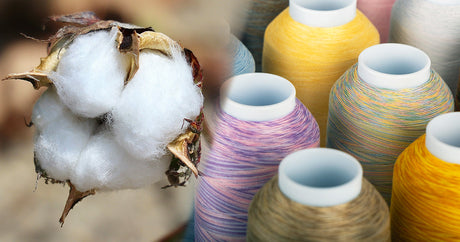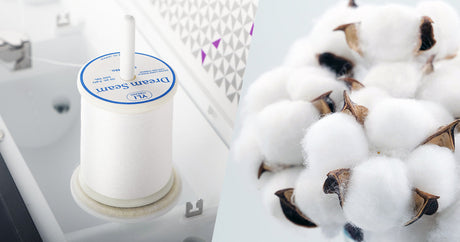We are excited to share award-winning quilter Tammy's top five tips for hand quilting using her favorite cotton hand quilting threads, including advice every quilter, from beginner to seasoned stitcher, can benefit from.
A Quilt Years in the Making
Some quilts require patience, and some require passion; this award-winning quilt, My Heritage, required both. Specifically created for the Kutztown Folk Festival—the oldest continuously operated folklife festival in America—this hand‑quilted beauty represents an amalgamation of skill, dedication, and commitment.
Every stitch tells a story, honoring Pennsylvania German folk art with meaningful symbols: the distelfink bird represents happiness, hearts symbolize love, and tulips signify faith. Attention to detail and dedication to tradition shine through every inch.
The Art of Hand Quilting
Tammy has been hand quilting for 40 years, and her expertise is reflected in every stitch of her quilt. She brought her vision for My Heritage to life using our 40 wt. quilting cotton thread, which is ideal for hand quilting, and chose blending colors to complement the intricate stitch designs and wholecloth quilt pattern. Explore our hand quilting thread collection and learn why it has been a favorite among hand quilters for over two decades.
Her specialty is wholecloth quilts. For many quilters who prefer to stitch by hand, there's something deeply satisfying about making a wholecloth quilt. It's simple in concept: a single piece of fabric, no patchwork or piecing, but the finished quilt can be absolutely breathtaking. Instead of relying on quilt blocks pieced together or printed patterns, the quilt's beauty comes entirely from the stitches. It's the kind of project where your quilting really shines, where your thread and needle tell the whole story.
Wholecloth quilts possess a deep sense of heritage. They feel timeless and refined, like something that has been passed down through generations. The designs are often traced or marked by hand, sometimes just freehanded, and then brought to life one stitch at a time. For quilters who love the rhythm of quilting by hand, it's a soothing and rewarding way to work. Read our educational article about what makes a high-quality cotton thread different from a low-quality thread.
 My Heritage, award-winning quilt by Tammy W.
My Heritage, award-winning quilt by Tammy W.
There's also a practical side to it. Without all the seams and bulk of a pieced top, the fabric is easier to handle. It's smoother on a frame or in a hoop, and there's no need to worry about matching corners or lining things up just right. A simpler setup that makes it easier to focus on the little things, like making your stitches evenly spaced, carefully blending colors, or testing a new motif or stitch pattern.
For quilters with experience in hand quilting, a wholecloth quilt is more than just another project. It's a way to connect to tradition, to slow down, and to let the quilting itself be the art.
A Bittersweet Victory
In July 2024, My Heritage won the Grand Prize at the Kutztown Folk Festival, earning a place among the top 24 quilts chosen from over 2,500 locally handmade entries. It was a well‑deserved honor for a quilt that represents the tradition of hand quilting.
But the triumph was also bittersweet: this was the festival's final year, just shy of its 75th anniversary in 2025. For those lucky enough to see My Heritage in person, it served as a poignant reminder of the rich history of quilting and the importance of preserving these time-honored techniques. Winning the Grand Prize was a fitting tribute to the substantial effort that went into completing it over two years.
Hand quilting requires patience, skill, and, of course, good thread. Especially if you're just starting your journey with hand quilting, choosing a strong, glazed cotton hand quilting thread is a great way to get started on the right track. When every stitch is made by hand, the materials you choose really do make a difference. A smooth, strong thread helps the needle move through the layers without tugging or breaking, and it gives your quilting that clean, even look we all strive for.
Choosing the right thread not only makes the process more enjoyable, but it also helps your work stand the test of time. For quilters who spend months or even years on a single quilt, selecting high-quality materials is crucial. Take the time to enjoy creating something beautiful, one stitch at a time.


Tammy's Tips for Hand Quilters
Q: What are the three most important traits to consider when choosing a preferred thread for hand quilting?
A: For me, it's color, strength, and how easily the thread glides through the fabric without tangling. My go-to color is usually a light brown, with ecru as a close second.
Q: What is a piece of helpful advice you've received?
A: Don't make your stitches so small that they look like dots. You want them to look like actual stitches.
Q: What advice would you give to others?
A: Focus less on making your stitches tiny and more on making them consistent. The smaller stitches will come with time and practice. When I demonstrate hand quilting in a class, people often say I make it look easy, but I've been doing this for 40 years. Be patient with yourself, relax, and enjoy the process. It's a rewarding and beautiful skill.
Q: What inspires you to hand quilt?
A: Hand quilting gives me a real sense of pride. There's something meaningful about creating something entirely by hand, even though a machine could technically do the job. When I'm hand quilting, I can watch the design, whether it's a pattern or a stencil, come to life with every stitch. It's incredibly satisfying and rewarding.
I also love the community side of hand quilting. I've spent many hours around a quilt frame with friends, working on group projects or quilting bees in the community. The conversation is always wonderful. We swap tips, share recipes, and even solve a few of the world's problems along the way.
Q: What steps do you take to set yourself up for success when starting a new hand quilting project?
A: Hand quilting is a time commitment, so I choose projects that fit the season and my schedule. In the summer, when I'm busy with things outdoors, I usually take on smaller quilts. In the winter, I know I'll have more time indoors, so I plan for larger projects. A comfortable chair and good lighting are essential.
I let the quilt pattern guide how I'll quilt it. I rarely use stencils anymore. I also take time to choose a thread color that coordinates or adds just a bit of contrast. When I worked in a quilt shop, I saw some beautiful work done with colored threads and have been inspired to use them more frequently as they can really add something special.
Practical Tips I Like to Share:
- Always start and finish with a knot, and bury your knots between the quilt layers
- Use about 18 inches of thread at a time. Once you master that length, try to increase up to 36 inches to see what works best for you
- As your skills improve, you'll be able to load 5 to 7 stitches on the needle at once. That rocking motion helps keep your stitch length consistent and makes the work go faster
Q: How have you perfected your quilting stitch over the years? What do you do differently now than when you first started?
A: I can definitely load more stitches on my needle than I could when I started. I've also learned to trust my eye. I used to mark a quarter-inch line away from every seam. Now, I can eyeball that spacing with confidence.
About YLI's Cotton Hand Quilting Thread
YLI Hand Quilting Thread is a 40 wt. glazed cotton thread made from 100% Egyptian‑grown extra‑long staple cotton. Quilters have trusted this thread for over 20 years because it glides smoothly through fabric without knotting or tangling.
Perfect for all hand quilting stitches, from precision running stitches to durable backstitches, our thread delivers consistent, lint-free, tangle-free performance that hand quilters rely on for beautiful, long-lasting results. Ready to implement these tips?
Find your perfect thread for hand quilting here








